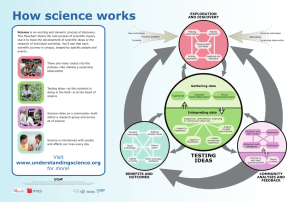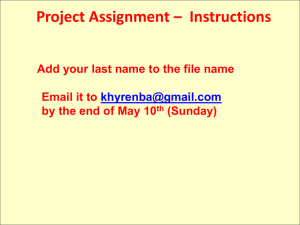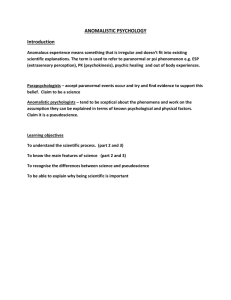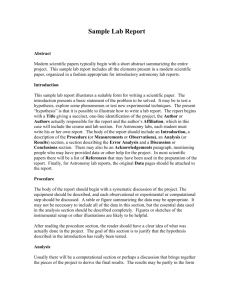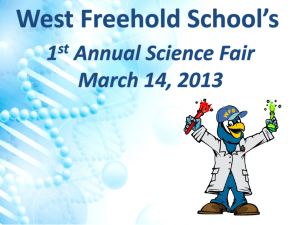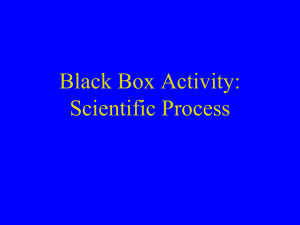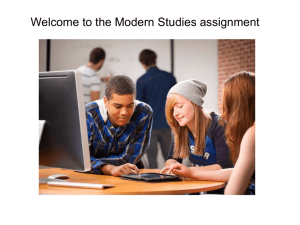ppt
advertisement
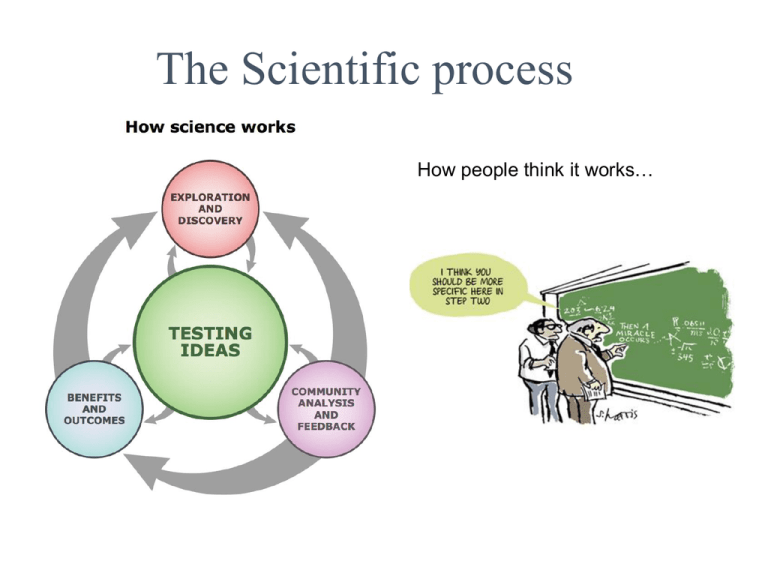
The Scientific process How people think it works… So, what is a scientific theory? The word "theory" means something very different in everyday language than it does in science: to the average person, a theory is just an idea… A scientific theory is an explanation of something that has been demonstrated through repeated experiments or testing. A scientific theory also makes predictions that can be tested. How are scientific theories developed? How science works EXPLORATION AND DISCOVERY Making observations New technology Asking questions Personal motivation Practical problem Serendipity Curiosity Surprising observation Sharing data and ideas Finding inspiration Exploring the literature Gathering data Expected results/observations Hypotheses Actual results/observations Interpreting data Supportive, contradictory, surprising or inconclusive data may ... Develop technology Address societal issues ... inspire revised assumptions. ...support a hypothesis. ... oppose a hypothesis. Build knowledge Satisfy curiosity ...inspire revised/new hypothesis. Inform policy Solve everyday problems BENEFITS AND OUTCOMES TESTING IDEAS Feedback and peer review Replication Discussion with colleagues Publication Coming up with new questions/ideas Theory building COMMUNITY ANALYSIS AND FEEDBACK www.understandingscience.org © 2008 The University of California Museum of Paleontology, Berkeley, and the Regents of the University of California Example of a theory that has been tested: A new theory was postulated in the early 1900s to explain geologic evidence:“Plate Tectonics” •Earth’s surface is divided into many plates that move slowly over the surface and interact with each other •Their movements are driven from below - internal heat and convection in the Earth •This was a REVOLUTIONARY idea when proposed "Extraordinary claims require extraordinary proof.” Marcello Truzzi The Scientific Method as school & science fairs often present it What do you see missing here? Science Process in astronomy • In astronomy, we can’t easily “conduct experiments” - we need to patiently wait for nature to carry out experiments that we can observe • We start with process for distributing telescope time at Kitt Peak (or, what is Colette doing today, Oct 25-26?) Take-away message: Scientists deal with natural events which can be observed, measured, and tested by scientific methods. Scientific study is based upon the assumption that the universe is orderly, reasonable, and testable. A valid scientific theory offers a well-defined naturally occurring cause (mechanism) which explains why or how a natural event (phenomenon) occurs. Scientific theories are always subject to change. The processes of science are very successful in dealing with problems within the limits of science. Homework: the scientific process. Read article about asteroids and dinosaurs and Index: Things we might test: Is the moon really larger when its on the horizon? Is it true that you can only balance an egg on its end on the equinoxes? Is the moon larger when it rises than a few hours later? I took this picture a few minutes after moon rise, Nov. 16 , a few years ago I took the second picture at 10:30 PM, with same setup Which is larger? Measure and find out! • • • • • • • • • • • • • • Common Elements of Pseudoscience Dr. Douglas Duncan University of Colorado Not all characteristics are always present, but many often are. If you see them, watch out! Without proper scientific skepticism you may well get fooled, sometimes jeopardizing you money or your health. Remember, “Science is a Way of Trying not to Fool Yourself!” – Nobel Prize winner and wonderful character Richard Feynman. How to tell if something is Pseudoscience. Beware if it… Is based on Post-diction, not Pre-diction (story is made up after the fact) Explains things people care about that may not have other explanations (avoids the scientific response, “We don’t know,” which people often find unsatisfactory) Uses scientific-sounding language and jargon (often incorrectly; e.g. “energy flows”) Does NOT use the scientific method of clearly stating the hypothesis and then making a test Usually has an explanation even when the idea fails (e.g. “astrology is only a tendency,” “the faith-healing treatment must have been started too late,” etc.) If it contradicts known scientific principles or is not generally accepted, the originator of the theory claims to be “persecuted by the scientific (or other) establishment,” is not recognized because “the jealous establishment,” etc. How Science is actually conducted • A scientist, often a team, describe how they test a new phenomenon, which may come from an idea, or may spring out of other work… • Results published in a peer reviewed journal • Many other scientists try to replicate the first study: if they can, the hypothesis gains credibility in the field • Peer review, refereed journals: papers submitted are sent to anonymous referees, experts in that area, for comments. Etc. Article not published until referee is satisfied
